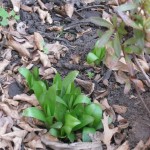Here is a tally of the 2nd wave of seedling starts:
phlox: 7 out of 12 starts
blue knoll: 3 out of 12
dianthus valentine: 6 out of 6
delosperma: 4 out of 6
Due to the low germination rates on the blue knoll chrysanthemum, I immediately used up any remaining seed that I had left. I also emptied the remainder of phlox seeds in the tray, in hopes of getting the maximum 12 starts.
Of the first wave of seedlings, I recorded the heights from tallest to shortest:
- sweet basil
- bell pepper
- calico
- purple flash
- red rubin
- pansy
What is disappointing from the list above is the performance of the red rubin basil. I had hoped to use a few specimens as accent color in the purple garden, but they have barely increased in size in almost a week.
Today’s starts:
4 dahlberg daisies: super fine, eyelash-shaped seeds!
8 vinca: using jiffy pellets and stored in the laundry room in complete darkness
4 garlic chives: don’t know why I’m having difficulty with these this year
In a green quart pot I placed a root cutting from the foxtail fern…not sure it will do anything, but I’d be interested in seeing the outcome.
All three of the Hot Lips salvia cuttings that I brought in are displaying tender leaves, just like the parent plant in the courtyard lily bed. Alas I have not been able to see any sign of the purple pastel that I sowed some time ago. And one of the 3″ pots is hosting a salvia seedling, the likes of which I haven’t seen before in any of the greggii cultivars. Is it a white? Red? Purple? Or some other hybrid? Only time will tell.
The pineapple mint (2) and hot and spicy oregano (1) cuttings have taken to their new home with vigor. They appear to be putting out new growth–a testament to their light-loving nature. The catmint has remained tall and floppy, surprising me every day with new growth. It’s still a tender thing, disliking heavy watering.
I’m not sure how I will be thinning the impatiens and alyssum seedlings; it seems too much work at this time to separate them. They still look too fragile, about 6 weeks into their lives, to be transplanted or removed from the dome protection they currently enjoy. Well, there is still another 4 weeks of March to go…no telling what growth spurts I will witness.
Other statuses: asters growing tall and gangly with new shoots, rosemary cuttings looking pale and deathly, no telling what’s growing in one of the Mexican heather pots, oriental limelights perking up, felicia seem contemplative, and the columbine are starting very slowly.
Now I have these two hippeastrums sitting in a bag, begging to be planted. I can’t be sure what cultivar they are, but reading suggests that these garden amaryllis may be part of a group of Sonatini hybrids. On the bag label is the distributor name Van Zyverden but their site is non-existent. Further research revealed that these hippeastrums were developed by a South African company known as Hadeco. However their site info is woefully inadequate and gave me no clue as to what to expect from the mystery bulbs. This should teach me from impulse buying flower bulbs. Anywho, they’re slated for burial in the courtyard lily bed.
One perennial on my wishlist that has proven elusive is the Ajuga Dixie Chip. Perhaps in the coming months, I’ll be finding them at the local home improvement nursery.




















